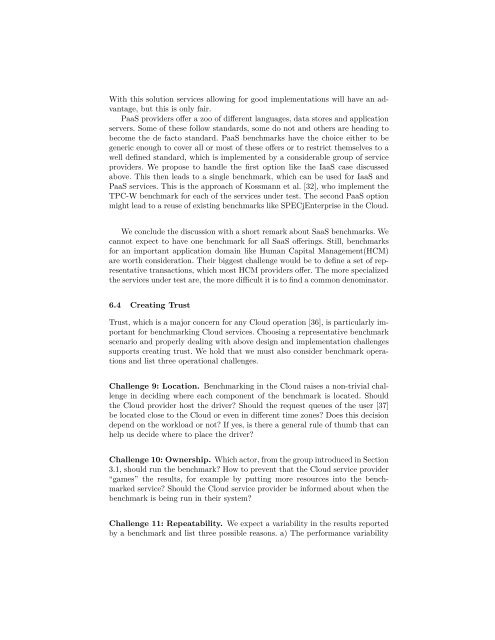Benchmarking in the Cloud - Parallel and Distributed Systems
Benchmarking in the Cloud - Parallel and Distributed Systems
Benchmarking in the Cloud - Parallel and Distributed Systems
You also want an ePaper? Increase the reach of your titles
YUMPU automatically turns print PDFs into web optimized ePapers that Google loves.
With this solution services allow<strong>in</strong>g for good implementations will have an advantage,but this is only fair.PaaS providers offer a zoo of different languages, data stores <strong>and</strong> applicationservers. Some of <strong>the</strong>se follow st<strong>and</strong>ards, some do not <strong>and</strong> o<strong>the</strong>rs are head<strong>in</strong>g tobecome <strong>the</strong> de facto st<strong>and</strong>ard. PaaS benchmarks have <strong>the</strong> choice ei<strong>the</strong>r to begeneric enough to cover all or most of <strong>the</strong>se offers or to restrict <strong>the</strong>mselves to awell def<strong>in</strong>ed st<strong>and</strong>ard, which is implemented by a considerable group of serviceproviders. We propose to h<strong>and</strong>le <strong>the</strong> first option like <strong>the</strong> IaaS case discussedabove. This <strong>the</strong>n leads to a s<strong>in</strong>gle benchmark, which can be used for IaaS <strong>and</strong>PaaS services. This is <strong>the</strong> approach of Kossmann et al. [32], who implement <strong>the</strong>TPC-W benchmark for each of <strong>the</strong> services under test. The second PaaS optionmight lead to a reuse of exist<strong>in</strong>g benchmarks like SPECjEnterprise <strong>in</strong> <strong>the</strong> <strong>Cloud</strong>.We conclude <strong>the</strong> discussion with a short remark about SaaS benchmarks. Wecannot expect to have one benchmark for all SaaS offer<strong>in</strong>gs. Still, benchmarksfor an important application doma<strong>in</strong> like Human Capital Management(HCM)are worth consideration. Their biggest challenge would be to def<strong>in</strong>e a set of representativetransactions, which most HCM providers offer. The more specialized<strong>the</strong> services under test are, <strong>the</strong> more difficult it is to f<strong>in</strong>d a common denom<strong>in</strong>ator.6.4 Creat<strong>in</strong>g TrustTrust, which is a major concern for any <strong>Cloud</strong> operation [36], is particularly importantfor benchmark<strong>in</strong>g <strong>Cloud</strong> services. Choos<strong>in</strong>g a representative benchmarkscenario <strong>and</strong> properly deal<strong>in</strong>g with above design <strong>and</strong> implementation challengessupports creat<strong>in</strong>g trust. We hold that we must also consider benchmark operations<strong>and</strong> list three operational challenges.Challenge 9: Location. <strong>Benchmark<strong>in</strong>g</strong> <strong>in</strong> <strong>the</strong> <strong>Cloud</strong> raises a non-trivial challenge<strong>in</strong> decid<strong>in</strong>g where each component of <strong>the</strong> benchmark is located. Should<strong>the</strong> <strong>Cloud</strong> provider host <strong>the</strong> driver? Should <strong>the</strong> request queues of <strong>the</strong> user [37]be located close to <strong>the</strong> <strong>Cloud</strong> or even <strong>in</strong> different time zones? Does this decisiondepend on <strong>the</strong> workload or not? If yes, is <strong>the</strong>re a general rule of thumb that canhelp us decide where to place <strong>the</strong> driver?Challenge 10: Ownership. Which actor, from <strong>the</strong> group <strong>in</strong>troduced <strong>in</strong> Section3.1, should run <strong>the</strong> benchmark? How to prevent that <strong>the</strong> <strong>Cloud</strong> service provider“games” <strong>the</strong> results, for example by putt<strong>in</strong>g more resources <strong>in</strong>to <strong>the</strong> benchmarkedservice? Should <strong>the</strong> <strong>Cloud</strong> service provider be <strong>in</strong>formed about when <strong>the</strong>benchmark is be<strong>in</strong>g run <strong>in</strong> <strong>the</strong>ir system?Challenge 11: Repeatability. We expect a variability <strong>in</strong> <strong>the</strong> results reportedby a benchmark <strong>and</strong> list three possible reasons. a) The performance variability















